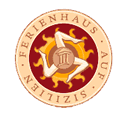
Savoca is film history thanks to the mafia strip “The Godfather” and Savoca lives thanks to the aristocratic mummies which attract many tourists who like to be given the creeps.
On a tour through the village Savoca (1.650 inhabitants) you pass along the church San Michele and San Nicolò, until the mother church (klingt merkwürdig) which is a bit farer away. It stems (evtl. dates from/comes from?) from Norman times and exudes a wonderful atmosphere. Sicily is connected very strongly with the Catholic belief and exactly this church depicts this connection by an inconsiderable ligation, it is the symbol of Catholicism on Sicily.
During the walk through Savoca we let bewitch (lieber enchant, verzaubern - verhexen) ourselves by the panorama which is offered to us.(letzten part lieber löschen) At good weather – what nearly always is the case on Sicily – you have impressive clear views on the Agrò valley, a wonderful, hilly landscape. After so much marching you get thirsty and you especially thirst after a visit in the characteristic bar Vitelli which is eternalised in the film “The Godfather”. But you do not enjoy staying for long in the homelike bar, because the continuous sprinkling with the same film music is not good for everybody’s nerves. But at least we take some nice pictures for our holiday album, but only with our humble selves and without the attractive Al Pacino.
The museum with the mummies is located in the Capuchin monastery at the main road. It is administrated by nuns and the opening hours are constraint to mornings until 13 o’clock. The mummies stem(s.o.) from the time between 1700 and 1876. Bald skulls and skeletal hands peer from the somewhat loophole but still fancy clothes with stitches and falbalas. Some of the dead aristocrats still wear elegant shoes with a silver buckle on their bony feet. Would the nobles be embarrassed if they knew that they have become bogeys? On the other hand: there are people who are not considered ever at life times!
Also in the Agrò valley lays the cosy village Casalvecchio Siculo, behind Savoca and about 400 metres over sea level. An impressive witness of this era is the Peter-and-Paul church in the valley of Casalvecchio. The church, which is built of red, black and white stones, was reconstructed after an earthquake in the year 1117. The type reflects the influence of Normans as well as of Arabs and Byzantines. It is the simplicity which sets the belief in the centre instead of the power. Unfortunately, you can not visit the church always. An also interesting little Byzantine church is the Cuba of Santa Domenica in the close Alcantara valley.
The village Casalvecchio counts about one thousand inhabitants and everyone knows each other like in every little village. When the sun show its power during the summer months and takes possession of the island, the Sicilian allows himself a refreshing Granita (ice-cream) with a warm bap (Brioche) for breakfast. The bar at the main road makes amongst others a delicious Granita of strawberries, an absolute must…Like it is with all delicacies on Sicily, it is disadvised to count the calories…just enjoy.
The place may be small, but it still offers some sights. If you follow the little alleys to the right of the main road (coming from the sea) up the hillside, you get to the village fountain. Ceramics which were painted by hand tell stories of former everyday life: of the labours and pleasures. There were separations at the fountain, or now rather called spring: just at the top the drinking water bubbled out; a part of the fountain was meant for the washwomen and another section was considered to be the drinking trough of the animals.
The baroque village church is devoted to the village saint Saint Onofrio, it stems from the 17th century A.D. and it took extensive damages at the earthquake in the year 1908. In the honour of Saint Onofrio, a village feast takes place on the second Sunday in September. A very humorous figure and strongly connected with the village and its history is the camel “U Camiddu”. A man who is dressed like a camel is chased through the village during the festivities; the poor animal is punched, bantered and yelled at until it finally gets tamed under the drumming of the reel. The camel-tamer is no one less than Casalvecchio, the whole village and the poor animal depicts the neighbour village Savoca which Casalvecchio was dependent of until 1793. How you get the idea of a camel in a little mountain village, where far and wide none of these ships of the desert are to be found? The two humps of the camel depict the Monte Bivertice near Savoca; that is why the poor animal has to be the scapegoat.